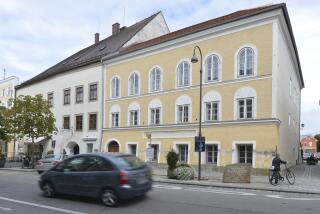GERMANY : Nazi Bunker Stirs Deep Divisions
- Share via
BERLIN — Do parts of Adolf Hitler’s bunker complex belong in the new government quarter planned here? Some of the city’s key elected officials and bureaucrats involved in planning the new German capital district in Berlin say yes.
“Germans need to face their history,” said Alfred Kernd’l, head of the city’s Archeological Department. “People need to see it, not destroy it.”
Kernd’l has the backing of the two city government ministers responsible for the matter--Ulrich Roloff-Momin, who deals with cultural affairs, and Volker Hassemer, head of the Urban Development and Environmental Affairs Department.
But leaders of the city’s Jewish community see it differently. They want the bunker to remain just as it is: buried with hardly a trace. While Berlin’s Jewish elders were unavailable for comment this week, after the death Sunday of the community’s longtime leader, Heinz Galinski (see story, A10), their position is well-known.
They fear that a part of the Fuehrer’s bunker complex, preserved as a national monument amid the new Germany’s corridors of power, would create a potential rallying point for the country’s extreme right wing and, at worst, become a mecca for neo-Nazis throughout Europe.
During the dying days of World War II, Hitler directed the defense of Germany and its capital from the series of underground bunkers adjacent to the Third Reich’s chancellery in central Berlin. Eight days before the war ended, and with the Red Army closing in, Hitler and his wife of one day, Eva Braun, committed suicide there.
At a meeting two weeks ago with Jewish leaders, city officials said both sides agreed that they share a common goal--that the past must not be forgotten--but admitted there was no accord on how this could best be done.
“We are very sensitive to these worries,” said Wolfgang Abramowski, spokesman for the city’s Cultural Affairs Department. “But both positions have to be understood. There must be a way around this. How can you pretend that those bunkers never existed?”
Confident that some form of compromise can be reached, the city is proceeding to integrate the bunker into detailed planning, despite the concerns of the Jewish community. How the site would be marked and what kind of access the public would have to the bunker are decisions that won’t be made for another two to three years, Kernd’l said.
Barring bureaucratic delay, the legal protection given to historic buildings is expected to be issued routinely by the end of next month, he said.
That there is anything of the bunker complex worth preserving is a surprise development that only followed the collapse of the Berlin Wall in November, 1989. After capturing the city in spring, 1945, Soviet forces believed they had located and destroyed the complex, which consisted of about a dozen separate bunkers. For almost three decades, from 1961 to 1989, the site lay abandoned in the infamous “death strip” just behind the Berlin Wall.
In the late 1980s, the Communists built apartments on the eastern edge of the no man’s land, carefully avoiding the bunkers.
The spot 20 feet above where Hitler killed himself April 30, 1945, is today a children’s playground.
It was only when munitions experts combed the area for possible unexploded World War II bombs in preparation for a 1990 rock concert that a forgotten part of the bunker complex was discovered in near-perfect condition. The rooms, roughly 200 yards west of Hitler’s personal bunker, were used by the Nazi leader’s drivers and others of his personal staff.
Large undamaged frescoes depicting the brave new world of totalitarian life still decorate the walls. The furniture remains intact, and Kernd’l displays an array of trinkets that were recovered from the bunker.
He indicated they would probably be returned to the bunker once it was restored.
A second, damaged bunker, initially built as an air raid shelter directly under the chancellery about 75 yards southwest of the 1990 discovery, has also been inspected for possible renovation.
“Both (bunkers) have to be integrated into the development design,” Kernd’l said. “I’m in favor of allowing the public to get into both of them.”
More to Read
Sign up for Essential California
The most important California stories and recommendations in your inbox every morning.
You may occasionally receive promotional content from the Los Angeles Times.













